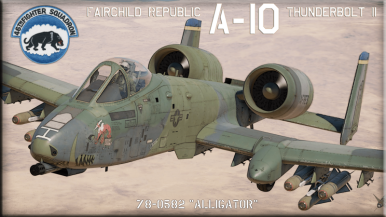



The Fairchild Republic A-10 Thunderbolt II (nicknamed Warthog) is an American subsonic attack aircraft designed for close air support of ground forces on the battlefield. After the end of World War II, the focus of American military aviation shifted towards producing tactical aircraft capable of delivering nuclear weapons. However, with the onset of the Vietnam War, it became apparent that the most common American attack aircraft, the A-1 Skyraider, was hopelessly outdated, and operating the F-4 Phantom II as an attack aircraft was very expensive.
In May 1970, initial requirements were formulated, including the necessity to design an aircraft around a new 30 mm cannon with a rotating barrel assembly. After a series of tests, the YA-10A from Fairchild Republic was declared the winner, and in January 1973, the aircraft entered production. After the US Air Force received the first production version of the A-10 in November 1975, the aircraft was officially named Thunderbolt II in April 1978, in honour of the World War II-era P-47 Thunderbolt fighter-bomber, also built by Republic. Although the A-10 was first delivered to troops in March 1976, its first combat use did not occur until 1991 during the Persian Gulf War. It also participated in the invasions of Iraq and Afghanistan.
Introduced in Update "Wind of Change", the A-10A (Late) fully embodies the role of an attack aircraft. The Thunderbolt has an arsenal that includes multiple calibres of bombs, air-to-ground guided missiles, AIM-9L all-aspect air-to-air missiles with infrared seekers, and Hydra rockets. With this substantial payload, it can deliver precise strikes against the enemy, and the ability to customise its loadout provides more options on the battlefield. However, the Warthog's modest flight characteristics require players to operate with caution. Compared to its premium counterpart, the A-10A (Early), it lacks guided bombs, but this is compensated by the presence of the more advanced AGM-65D air-to-ground missiles and four AIM-9L air-to-air missiles.
flaps
flaps
flaps
brake
| Belt | Belt filling | Armor penetration (mm) at a distance: | |||||
|---|---|---|---|---|---|---|---|
| 10 m | 100 m | 500 m | 1000 m | 1500 m | 2000 m | ||
| HVAP-T/HEI/HVAP-T/HEI | 79 | 77 | 68 | 58 | 50 | 43 | |
| HVAP-T/HEI/HVAP/HVAP | 79 | 77 | 68 | 58 | 50 | 43 | |
| HVAP-T/HEI/HEI/HEI | 79 | 77 | 68 | 58 | 50 | 43 | |
| HVAP/HEI/HVAP/HEI | 79 | 77 | 68 | 58 | 50 | 43 | |
| Name | Weight | Slot | ||||||||||
|---|---|---|---|---|---|---|---|---|---|---|---|---|
| 84.5 kg |  |  | ||||||||||
| 2 × | 168.9 kg |  |  | |||||||||
| 240.9 kg |  |  |  |  |  |  |  |  |  |  | ||
| 254 kg |  |  |  |  |  |  |  |  |  |  | ||
| 7 × | 101.1 kg |  |  |  |  |  |  | |||||
| 21 × | 393.4 kg |  |  |  |  | |||||||
| 3 × | 722.7 kg |  |  |  |  | |||||||
| 3 × | 762 kg |  |  |  |  | |||||||
| 893.6 kg |  |  |  |  |  |  | ||||||
| 893.6 kg |  |  |  |  |  |  | ||||||
| 3 × | 680.4 kg |  |  | |||||||||












Flight performance |
|---|
Survivability |
|---|
Weaponry | ||
|---|---|---|

